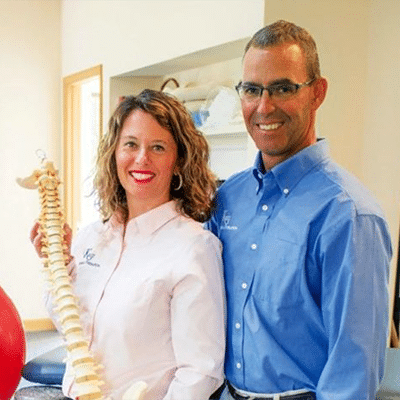When the pandemic hit it seemed as though there was a mass exodus to work from home: from store managers to doctors, everyone unplugged their PC’s, loaded them in their cars, and set them up in the kitchen, living room, and garage – for those fortunate enough to have a study, the computer now has pride of place next to the photo of grandma. Now, working from home has its benefits, right? You can do your laundry and still hop on that Zoom call, or you can help the kids with their homework and still find time to fill out that spreadsheet for tomorrow. Yet, as good as all that sounds, there are some down sides, too… what about that gnawing pain in your neck? How’s your back today… a little off? How many times have you tried to stretch your shoulder out yet have had no luck? As you’ll see in this post, remote working can have pretty dramatic effects on your body if you’re not careful: we’ll run through what those are AND how to resolve them so that you can get back to a 9 – 5 that resembles some type of normalcy. Here we go!
Now, my guess is that you understand the fact that the body relies on good posture for a pain free day-to-day, right? In other words, if you’re slouching from dusk till dawn, it won’t be surprising to find that your neck and lower back are a bit tender at the end of the day. Well, with that in mind, your work environment at home plays a direct role in how physically well you feel day in and day out. If your desk is in the kitchen and you have to stretch over the ketchup, make way for the kids’ breakfast bowls, and you have to contest with your partner’s equally important ‘desk’ space, then you’re going to run into a few issues. The key word to remember is… ergonomics.
What’s that? Well, ergonomics is really just the way you’re positioned so as to ensure that your body is able to function at its best. So, when we speak about desk ergonomics, we like to think that the following needs to be right:
- The chair to table height ratio: are you sitting too high or low in relation to the table or desk you’re working at? Adjust the ratio if this is the case.
- The height of your seat versus the height of your screen: whether you’re working from a laptop or a desktop, the height of your screen or monitor is very important. If you’re stretching up to see the screen, please adjust it downwards. Alternately, if you’re leaning down to see the screen, the monitor needs to be lifted higher. Make sure your neck remains level and that you don’t need to stoop or stretch. Need I say that working with a laptop on your knees is a very, very bad idea?
- Back support: Is your lower back supported adequately by your seat? If you’re sitting on grandpa’s Lazyboy then it’s time to upgrade.
- Keyboards matter: make sure you’re typing on a keyboard that’s accessible and in a comfortable position. If you’re working from a laptop and find it difficult to type, try to source a keyboard in order to reduce the strain placed on your neck.
It’s fair to say that most homes aren’t equipped for working from home. And let’s be honest, no one really saw the last year and a half coming, did we? We need to change our thinking, though, and make our environment as conducive to healthy working as possible. After all, if you’re in pain you can’t really produce quality work, right?
Desk ergonomics isn’t the only important factor, though. Despite the fact that many of you have been cooped up indoors for a while, you have to think about ‘movement’. If you’ve made your office in the kitchen, please remember that it is still your kitchen. Do not be tempted to make every waking hour one in which you work. Take regular breaks, step away from the screen, stretch, leave the house, and get some sun. It is so tempting to get lost in the screen largely because you don’t need to worry about traffic, you can’t hear Jim gossiping at the water cooler, and you didn’t have to pack lunch… but all this aside, you have to remember that work is work and that there is a time and a place for everything. Get up, drink some water, and get away from that computer!
While you’re at it – please stretch. Sitting at your kitchen table / desk can really take its toll on your muscles. You’ll become stiff and achy if you don’t stretch regularly. Make time to get on the yoga mat or simply stretch out on the carpet in the living room. You don’t need to attend a Hot Yoga class each day, but make sure to give your muscles the exercise and strengthening routine they crave. Not only will this help you avoid stiffness and pain the future, but it will also alleviate the day’s stress and tension, thereby helping you delineate a healthy work / life balance.
It really is difficult working from home; there is a lot to think about which, if things were different, you may not have needed to consider. From desk ergonomics to breaks, things can be difficult to juggle. If you haven’t been able to, though, and you find yourself in pain, don’t fear. Simply contact a hands-on, qualified physical therapist for the help and treatment you need. With a dedication to finding the root cause of your problem – be that posture or something else – a physical therapist will eradicate the pain and give you the tools you need to stave off any future pain that may arise. Not only that, but he/she will also give you the tools you need to create the perfect ergonomic work-space and daily healthful routine via informed advice, stretching techniques, and exercises. In fact, physical therapy is so good that whether you’re in pain or not, visiting a hands on physical therapist may just help you avoid any discomfort you may potentially encounter.
So, whether you’re faced with going back to the office in the near future, or you see yourself working from home for the long haul, take the above tips to heart and get your workspace in order. Say goodbye to pain and hello to a great work / life balance. Simply contact us for any information or advice you need to get started! We look forward to hearing from you.




